I played the game below in the middle of the 2007 Canadian Open. It involved a line of the Classical Orthodox QGD that may be seen as controversial, depending on how one views Black's chances after 7...dxc4, should he wish to play for more than a draw. Indeed, the Classical Orthodox as a whole often gets chessplayers on their high horses in one way or another...
I had been told just before the game that my opponent had done very well in the CYCC, also played in Ottawa, and thus given that he was a junior who was apparently hot, I had no misgivings at all about sticking with my previously selected solid Black repertoire choices for this lengthy tournament.
Unfortunately, I had planned on winning lengthy games if necessary, but in this case, when the opportunity came, I found that due to a combination of aging, a slight sleep deficit, mediocre fitness (at best), accumulated fatigue from earlier rounds, and a desire to save energy for the next day, I didn't have the will to try to win a very tough endgame, the proper result of which I still do not know. By the end of this event I had accumulated too many draws, including this one, to be able to hope for a prize:
[Event "2007 Canadian Open"]
[Site "Ottawa"]
[Date "2007.07.10"]
[Round "5"]
[White "Zhou H"]
[Black "Pacey K"]
[Result "1/2-1/2"]
[ECO "D63"]
[WhiteElo "2016"]
[BlackElo "2271"]
[Annotator ""]
[Source ""]
[Remark ""]
1.d4 e6 2.c4 d5 3.Nc3 Be7 4.Nf3 Nf6 5.Bg5 0-0 6.e3 Nbd7 7.Rc1 dxc4 8.Bxc4 a6 9.a4 c5 10.0-0 cxd4 11.exd4 Nb6 12.Bb3 Bd7 13.Ne5 Bc6 14.Nxc6 bxc6 15.Re1 Nfd5 16.Bxe7 Nxe7 17.Ne4 Nbd5 18.Qd3 Nb4 19.Qd2 a5 20.Rc3 Nf5 21.Rd1 Qh4 22.Ng3 Nxg3 23.Rxg3 Rfd8 24.Rh3 Qe4 25.Re3 Qf4 26.Qc3 Nd5 27.Bxd5 cxd5 28.Rc1 Qb8 29.Qa3 Qb6 30.Qc3 Qb7 31.Qa3 Rdb8 32.Rec3 h6 33.Rc7 Qb4 34.Qf3 Rf8 35.Qf4 Qxb2 36.h3 Rab8 37.Ra7 Rb4 38.Rxf7 Qxc1+ 39.Qxc1 Kxf7 40.Qc7+ Kg8 41.Qxa5 Rxd4 42.Qb6 Rxa4 43.Qxe6+ Kh8 44.Qxd5 Ra1+ 45.Kh2 Rxf2 46.Qd8+ Kh7 47.Qd3+ Kg8 48.Qc4+ Rf7 49.Qc8+ Rf8 50.Qe6+ 1/2-1/2
Here is the final position:
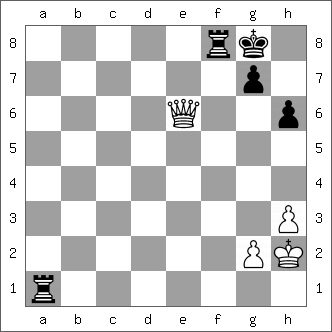
After doing a database search for this material balance, with h- and g-pawns, I discovered more than a handful of examples in my biggest database of games, with either a win for the rooks, or else a draw, resulting (no wins for the queen, as one could likely expect). The wins for the rooks more often than not involved charging the king out of its shelter all the way down deep into the the other side's camp, so that queen checks would run out. However a win often seemed to depend on the pawn structure being certain ways. In any case, the side with the rooks always played on for any number of moves.
I don't happen to own an Encyclopedia of Chess Endings volume that might cover this type of ending, nor do I have other books that comment on it. Perhaps someone would know how to assess it, in the case of the above game, or in general. Regretably (or charmingly?) a tablebase can't be used, since more than 6 pieces are involved.
I had been told just before the game that my opponent had done very well in the CYCC, also played in Ottawa, and thus given that he was a junior who was apparently hot, I had no misgivings at all about sticking with my previously selected solid Black repertoire choices for this lengthy tournament.
Unfortunately, I had planned on winning lengthy games if necessary, but in this case, when the opportunity came, I found that due to a combination of aging, a slight sleep deficit, mediocre fitness (at best), accumulated fatigue from earlier rounds, and a desire to save energy for the next day, I didn't have the will to try to win a very tough endgame, the proper result of which I still do not know. By the end of this event I had accumulated too many draws, including this one, to be able to hope for a prize:
[Event "2007 Canadian Open"]
[Site "Ottawa"]
[Date "2007.07.10"]
[Round "5"]
[White "Zhou H"]
[Black "Pacey K"]
[Result "1/2-1/2"]
[ECO "D63"]
[WhiteElo "2016"]
[BlackElo "2271"]
[Annotator ""]
[Source ""]
[Remark ""]
1.d4 e6 2.c4 d5 3.Nc3 Be7 4.Nf3 Nf6 5.Bg5 0-0 6.e3 Nbd7 7.Rc1 dxc4 8.Bxc4 a6 9.a4 c5 10.0-0 cxd4 11.exd4 Nb6 12.Bb3 Bd7 13.Ne5 Bc6 14.Nxc6 bxc6 15.Re1 Nfd5 16.Bxe7 Nxe7 17.Ne4 Nbd5 18.Qd3 Nb4 19.Qd2 a5 20.Rc3 Nf5 21.Rd1 Qh4 22.Ng3 Nxg3 23.Rxg3 Rfd8 24.Rh3 Qe4 25.Re3 Qf4 26.Qc3 Nd5 27.Bxd5 cxd5 28.Rc1 Qb8 29.Qa3 Qb6 30.Qc3 Qb7 31.Qa3 Rdb8 32.Rec3 h6 33.Rc7 Qb4 34.Qf3 Rf8 35.Qf4 Qxb2 36.h3 Rab8 37.Ra7 Rb4 38.Rxf7 Qxc1+ 39.Qxc1 Kxf7 40.Qc7+ Kg8 41.Qxa5 Rxd4 42.Qb6 Rxa4 43.Qxe6+ Kh8 44.Qxd5 Ra1+ 45.Kh2 Rxf2 46.Qd8+ Kh7 47.Qd3+ Kg8 48.Qc4+ Rf7 49.Qc8+ Rf8 50.Qe6+ 1/2-1/2
Here is the final position:
After doing a database search for this material balance, with h- and g-pawns, I discovered more than a handful of examples in my biggest database of games, with either a win for the rooks, or else a draw, resulting (no wins for the queen, as one could likely expect). The wins for the rooks more often than not involved charging the king out of its shelter all the way down deep into the the other side's camp, so that queen checks would run out. However a win often seemed to depend on the pawn structure being certain ways. In any case, the side with the rooks always played on for any number of moves.
I don't happen to own an Encyclopedia of Chess Endings volume that might cover this type of ending, nor do I have other books that comment on it. Perhaps someone would know how to assess it, in the case of the above game, or in general. Regretably (or charmingly?) a tablebase can't be used, since more than 6 pieces are involved.


 . Though I would have been satisfied with a draw in this particular game, I somehow didn't feel like giving him the satisfaction of hearing it.
. Though I would have been satisfied with a draw in this particular game, I somehow didn't feel like giving him the satisfaction of hearing it. 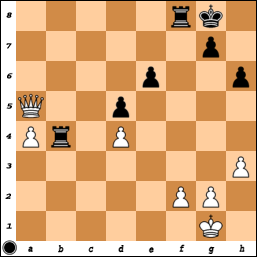
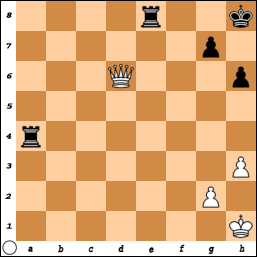
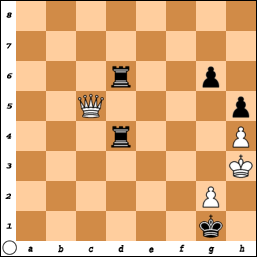
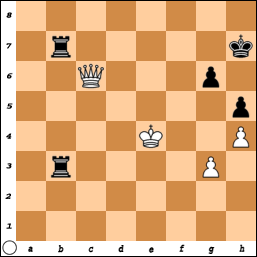
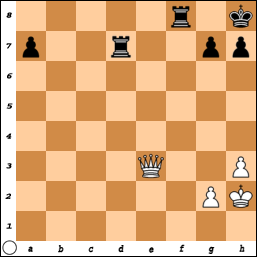
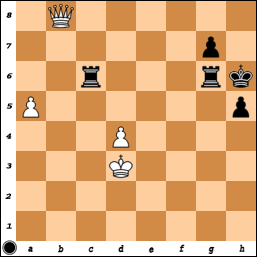
Comment